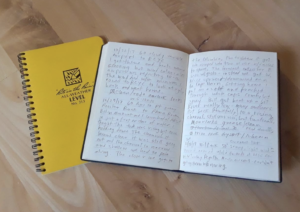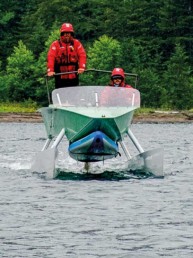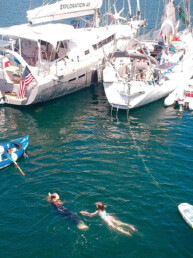No matter the size of the vessel, a log book still has a place aboard.
When I tell fellow sailors that I keep a log for my 18-foot sail and oar boat, they mostly look puzzled. Why would I want to do that? I see them wonder.

Sure, it’s an open boat, and my thwart-based nav station consists of a chart in a clear plastic case, a bright-yellow $40 direct-read ball compass, and a digital watch I got at a garage sale. But lack of serious gear doesn’t mean there’s no place for a log aboard a small boat. I don’t use my log like an offshore cruiser, plotting and recording conditions at set intervals during a day’s voyage. Instead, my log is a combination journal, travel guide, and maintenance record; an account of my adventures that allows me to understand my limits, track where I’ve been and where I want to go next, and deepen my knowledge about how to keep my boat in good working order.
I make an entry for each day I’m on the boat, whether it’s an hour-long escape from a hectic day or part of a multi-day cruise. Each entry’s header includes the date, start/end points, weather, and wind conditions. Next I record the general details of the day. On a single day circumnavigation of the 2,000-acre Government Island complex, I noted, “I went north first with good wind, not many motor boats, then west. The bay on the south end is shallower this year than I remember it.” The rest of the entry contained nothing particularly exciting, but at the end I made an important notation for a future voyage: “The last mile I rowed through an increasing number of wakes as the channel narrowed before a wing dam at the top of the island. Chop, standing waves, at least 2 knots of current. Headache!”

We all know what it’s like to question the safety of conditions as we prepare to set out for the day. On occasions like that, I thumb back through my log. “Force 4 wind, decreased to Force 3,” read the first lines of my journal from September. “Set 2 reefs in sail. It was gusty, lumpy, fun and scary with white caps, waves to 2 feet, and surges. Watch out for currents at mouth of Henderson Inlet.” Revisiting that entry prior to launching was a good reminder of what conditions my boat and I can actually handle.
The final line in each entry is a to-do list of little boat chores, the ones I used to forget needed attention until I was back aboard the next time, with a check box next to each item. “New line for mizzen rigging. Adjust floorboard turnbuckles.” Maybe I won’t get to these tasks soon, but when enough of them accumulate, I know exactly what to do and how to plan them out.
I also add entries for work done on the boat, from little stuff like greasing trailer bearings, to major work, like recording the date, brand, and number of coats of new bottom paint applied.
But my favorite parts of the log are the simple descriptions of a wonderful memory or a new place to visit. “Awake before dawn. Colorful, sublime sunrise on oily black water.” Note to self: return to Hope Island.
Whether it’s for a day, a weekend, or longer, next time you head out on the water, pull out your log and record the day’s events, you never know what gems you might capture for later.
Bruce Bateau
Bruce Bateau sails and rows traditional boats with a modern twist in Portland, Ore. His stories and adventures can be found at www.terrapintales.wordpress.com






